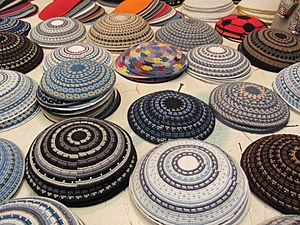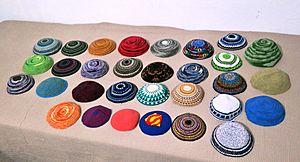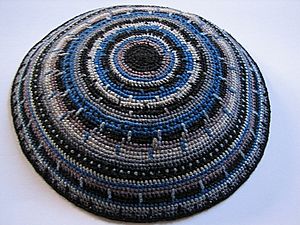Kippah facts for kids

A kippah (also called a yarmulke) is a small, round cap. It doesn't have a brim. Jewish men usually wear it to cover their heads. This is a tradition in Judaism. Many Jewish men, especially in Orthodox communities, wear a kippah all the time. You will often see kippot (the plural of kippah) available in synagogues and at Jewish events like funerals.
Contents
What is a Kippah?
The kippah is a special head covering. It reminds Jewish people of God's presence above them. It shows respect and humility. While it's a tradition, some Jewish groups believe it's a religious law to cover the head.
Different Kinds of Kippot
Kippot come in many styles, colors, and materials. The way a kippah looks can sometimes show what Jewish group a person belongs to, especially in Israel.
- Knitted or Crocheted Kippot: These are often worn by Religious Zionists and Modern Orthodox Jews. They might also wear kippot made of suede or leather.
- Black Velvet or Cloth Kippot: Members of most Haredi (also known as Ultra-Orthodox) groups usually wear these.
In the United States, the style of a kippah doesn't always show a person's religious group. People often choose kippot based on personal preference.
Modern and Special Kippot
Today, you can find many fun and unique kippot:
- Some kippot have colors of sports teams, like football teams.
- Children often wear kippot with cartoon characters or themes from popular movies like Star Wars.
- Kippot can be personalized. People sometimes have names or dates written inside them as a souvenir for special events, like a bar/bat mitzvah or a wedding.
- While traditionally worn by men, some women also choose to wear kippot.
- There are special baby kippot. These often have strings to tie them on. They are sometimes used during a Brit milah (a Jewish naming ceremony for baby boys).
Kippot and Other Head Coverings
The Samaritans are a group related to Jews. In the past, they wore blue head coverings to look different from Jews, who wore white ones. Today, Samaritans usually wear a type of hat called a fez with a turban. They mostly cover their heads during prayer, on the Sabbath, and during religious holidays.
Images for kids
-
Green kippah found in a Jewish home in Oświęcim, Poland. This kippah is part of the collection at the Auschwitz Jewish Center in Oświęcim.
-
An IDF soldier, Lt. Asael Lubotzky, praying with a kippah and tefillin (a small box containing scrolls with religious texts).
-
Rabbinical chaplain Sarah Schechter with fellow U.S. Airmen wearing camouflage kippot.
-
U.S. President Bill Clinton wearing a kippah during a visit to the grave of Yitzhak Rabin on Mount Herzl.
See also
 In Spanish: Kipá para niños
In Spanish: Kipá para niños








